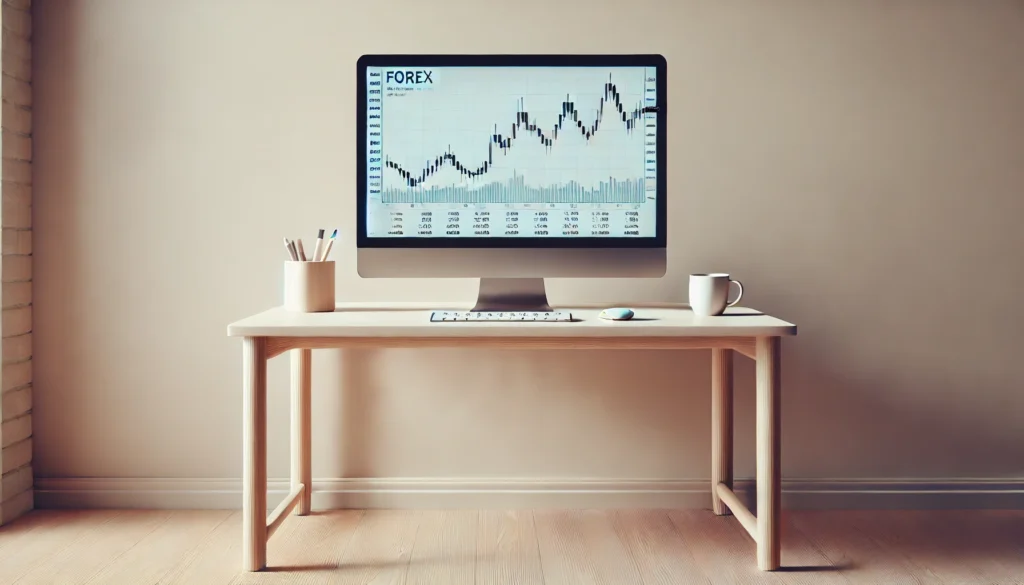
Forex trading is the process of exchanging one currency for another on the global market. Forex is the world’s largest and most liquid financial market, with a daily trading volume of more than $6 trillion. This vast market provides several potential while also posing considerable obstacles and complications. Understanding its underlying concepts, numerous trading tactics, and inherent hazards is critical for anybody interested in Forex trading. Let’s look at everything you need to know about forex, such as what it is, how to trade it, and how leverage works.
What is Forex Trading?
Forex trading is a type of trading based on foreign exchange. It is a worldwide marketplace where traders swap national currencies, and it is one of the world’s largest and most liquid asset exchanges. There is no central marketplace for forex. Instead, all trading takes place online, with primary markets operating 24 hours a day. Because of its worldwide nature, the forex market is extremely volatile, with values continually shifting in response to economic indicators, geopolitical events, and market mood.
Forex trading is fundamentally about trading forex pairs, with the base currency serving as the first and the quote currency as the second. For example, in the EUR/USD pair, the base currency is the euro (EUR), whereas the quote currency is the US dollar (USD). Traders purchase and sell currency pairs based on their expectations about how exchange rates will change.
The bid price represents what the market will pay for the base currency in exchange for the quotation currency, whereas the ask price represents what the market will sell it for. The spread, or the gap between bid and ask prices, represents the trader’s transaction costs.
What is Forex Pair?
A forex pair consists of two currencies that are exchanged against one another. There are hundreds of possible pairings, but some of the most common are the euro against the US dollar (EUR/USD), the US dollar against the Japanese yen (USD/JPY), and the British pound against the US dollar (GBP/USD).
- Major pairs – seven currencies account for 80% of worldwide forex trade. This includes EUR/USD, USD/JPY, GBP/USD, and USD/CHF.
- Minor pairs – less often traded and often involve major currencies against each other rather than the US dollar. Includes: GBP/CAD, EUR/CHF, and GBP/JPY.
- Exotics pairs – a major currency with one from a small or emerging economy. Includes: USD/MXN, EUR/ZAR, and GBP/SGD.
- Regional pairs – classified by region, such as Scandinavia or Australasia. Includes EUR/NOK, AUD/NZD, AUD/SGD.
Banks or individuals who want to buy a currency that will rise in value against the currency they sell carry out most forex transactions. However, if you have ever transferred one currency into another, such as while traveling, you have engaged in a forex transaction.
How does Forex Trading Work?
Forex trading is similar to any other transaction in which you buy one asset with a currency. In the case of forex, the market price indicates how much of one currency is needed to acquire another. For instance, the current market price of the GBP/USD currency pair indicates how many US dollars it would cost to purchase one pound.

Institutional forex trading occurs directly between two parties in an over-the-counter (OTC) market. There are no centralized exchanges, thus a global network of banks and other organizations manages the institutional forex market. The majority of traders that speculate on forex markets do not really hold the currency. Instead, traders will predict exchange rates in order to profit from market price swings.
Trading derivatives allows you to bet on the price swings of an asset without really owning it. For example, when trading forex using tastyfx, you may forecast the direction in which a currency pair’s price will go. The accuracy of your prediction affects whether you profit or lose.
The currency market is also used for hedging. This is when individuals and corporations use the market to protect themselves from currency fluctuations, insuring themselves against losses by putting their money in more advantageous currencies. This is an important aspect of many multinational firms nowadays and contributes to financial stability.
The forex market is divided into three important areas: margin, leverage, and order type.
- Margin is the amount of money required to start a trade.
- Leverage is borrowed money used to start a trade.
- Order type specifies the type of transaction you want to place, which can be market, limit entry, stop entry, stop loss, or trailing stop.
Types of Forex Traders
Traders use different tactics depending on their goals, risk tolerance, and time commitment. Forex traders are divided into four major styles: scalping, day trading, swing trading, and position trading. Each style has distinct qualities and necessitates a specific set of skills and tools.
Scalping
Scalping is the fastest method of trading. Traders seek to profit from small price swings over exceedingly short intervals. Scalpers often maintain positions for seconds or minutes, making fast judgments and performing a large number of trades every day.
Each trade attempts for a modest profit margin, generally only a few pips, with the total profit from multiple trades compounding over time. Because holdings are held for such short periods of time, this technique exposes you to the least amount of market risk. Scalpers frequently utilize heavy leverage to exaggerate modest price changes, which can result in large profits or losses. This trading method necessitates strong discipline and a continual concentration on the market, as opportunities come and go swiftly.
Scalpers make their trading decisions based mainly on technical indicators such as moving averages, Bollinger Bands, and oscillators like the Relative Strength Index (RSI). They commonly utilize limit orders to assure exact entry and exit locations, and they need high-speed trading platforms with low latency.
Day Trading
It is the process of purchasing and selling currencies on the same trading day, closing all positions before the market closes to prevent overnight risk. Day traders profit from intraday price swings by employing technical analysis as their primary tool.

Day traders open and close positions on the same trading day. This method reduces the risk of holding holdings overnight when unexpected developments can result in big price differences. Day traders aim to capture price fluctuations that occur during the trading day. They rely on good risk management measures to deal with the extreme volatility of intraday trading. They rely primarily on technical analysis, chart patterns, and indicators to locate trade opportunities.
Day traders utilize intraday charts, such as 1-minute or 5-minute charts, to track and evaluate price changes. They frequently use technical indicators such as moving averages, MACD, and volume analysis. Keeping up with economic news and events that produce considerable intraday volatility is critical.
Swing Trading
Swing trading is holding positions for a few days or weeks in order to profit from short- to medium-term price fluctuations. Unlike scalping or day trading, this strategy allows traders to profit from price movements over a longer period of time.
Swing traders focus on medium-term price movements, maintaining positions for days or weeks to profit from market swings. They make trading decisions using a combination of technical and fundamental analysis, with the goal of executing fewer but higher-quality deals. Patience is still an important trait for swing traders, as they wait for the appropriate moments and let transactions grow over time.
Swing traders use daily and weekly charts to track market trends and price fluctuations. They use technical analysis tools including chart patterns, trendlines, and indicators like moving averages and Fibonacci retracements to pinpoint entry and exit positions. Fundamental analysis takes into account economic statistics, news events, and central bank policy.
Position Trading
Position trading is the longest-term trading strategy, with traders holding positions for even years. Long-term trends and economic fundamentals are central to this approach, which is similar to long-term investing.
Position traders base their trading decisions mainly on fundamental analysis, such as economic statistics, interest rates, and geopolitical developments. Position trading entails a minimal number of deals, with traders focusing on large market changes. Patience and discipline are still required as traders hold positions despite market changes.
Position traders rely on fundamental analysis to comprehend economic data, central bank policies, and global economic trends. They also use technical analysis, such as long-term charts, to identify important support and resistance levels as well as trend directions. Economic models frequently lead long-term trend forecasts and possible market moves.
Note: Understanding these different approaches allows traders to select the technique that best suits their personality, time availability, and risk tolerance, ultimately increasing their chances of success in the Forex market.
Forex Trading Strategies
Forex trading strategies vary greatly but are broadly classified into four categories: technical analysis, fundamental analysis, sentiment analysis, and algorithmic trading. Each strategy provides unique perspectives and ways for navigating the complexity of the forex market.

Technical Analysis
Technical analysis is one of the most popular and commonly used tactics in forex trading. This strategy entails analyzing price charts and technical indicators to estimate future price fluctuations. Traders who use technical analysis believe that past price patterns and trends can provide useful information about future behavior.
Technical analysis relies significantly on a number of essential tools and methodologies. Traders use several chart formats, such as candlestick, line, and bar charts, to spot patterns and trends. Moving averages, which smooth price data, aid in determining the direction of a trend. Simple Moving Average (SMA) and Exponential Moving Average (EMA) are two often used moving averages.
Technical analysis provides unambiguous entry and exit signals, allowing traders to make better judgments. It aids in the identification of market trends and potential reversals, providing useful information for both short-term and long-term trading methods. Furthermore, technical analysis may be applied to numerous timeframes, making it suitable for a variety of trading strategies.
Fundamental Analysis
Fundamental analysis relies on economic indicators, news events, and geopolitical developments to forecast currency price movement. This technique takes into account elements such as interest rates, employment data, and GDP growth, all of which have a substantial impact on currency values.
Interest rates play an important role in basic analysis. Changes in central bank policies and interest rates affect currency values. Because higher interest rates frequently attract foreign capital, which leads to currency appreciation. Economic indicators such as employment numbers, inflation rates, and GDP growth provide information about a country’s economic health and potential currency moves.
Fundamental analysis provides a broader understanding of market dynamics, allowing traders to make more informed decisions. It helps in identifying long-term investment opportunities and informs traders about potential market-moving events.
Sentiment Analysis
Sentiment research provides another perspective on forex trading by assessing the overall sentiment of the market. This method evaluates trading behavior and market positioning to determine if the market is bullish or bearish on a specific currency.
The Commitment of Traders (COT) Report is a valuable tool for sentiment analysis. This report offers insights into the positions of major market participants, allowing traders to measure market mood. Volume analysis, which looks at trading volumes, can help you determine the strength of a price move and the market’s general attitude.
Sentiment analysis aids in spotting probable market turning moments, giving traders early warning of prospective reversals. It combines technical and fundamental analysis by providing a unique viewpoint on market conditions. Sentiment analysis is also important for contrarian trading methods, in which traders go against the current market sentiment to profit from anticipated market corrections.
Algorithmic Trading
Algorithmic trading is the confluence of technology and trading methods. This strategy employs automated trading systems and algorithms to execute transactions based on predetermined criteria. It eliminates emotional biases from trading judgments.

Algorithmic trading refers to rule-based systems that execute trades using certain criteria. For example, an algorithm may purchase a currency pair when it crosses above a moving average and sell when it goes below. Advanced algorithms employ machine learning and artificial intelligence to examine massive volumes of data and make trading judgments.
Algorithmic trading promotes consistency and discipline in trading. Because, algorithms faithfully adhere to specified rules and avoid emotional intervention. These systems are capable of processing and analyzing massive volumes of data quickly, allowing them to make informed judgments in real time.
How to Start Forex Trading
Starting Forex trading entails learning the fundamentals of the foreign exchange market and selecting a reputable broker. Begin by familiarizing yourself with important concepts, methods, and procedures. Here’s a checklist to help you get started:
- Learn about Forex: You now have the fundamental concepts, but you’ll need to learn more about the terminology and how the FX market works. This includes understanding currency pairs, market trends, and the factors that influence currency prices.
- Develop a trading strategy: Learn about numerous trading tactics, including technical analysis, fundamental analysis, and news trading. Choose a strategy that suits your trading style and risk tolerance.
- Create a plan: Make a trading plan that contains your objectives, risk tolerance, tactics, and the criteria you’ll use to evaluate deals. Disciplined traders are profitable merchants.
- Set up a brokerage account: Choose a broker regulated by a credible financial authority. Make sure the broker has an easy-to-use trading platform, strong customer service, and cheap costs.
- Practice with a demo account: Many forex platforms allow you to paper trade before investing real money. This is the moment to ensure that you have mastered all of the trading mechanics and tested your techniques.
- Start carefully: Once you’re comfortable with your practice trading, start trading with real money. Start modest to manage risk, then progressively increase your trade size as you acquire experience.
- Keep track of your holdings: Check your positions on a regular basis and make sure you have enough funds in your account. Use stop-loss and take-profit orders to reduce risk and maximize earnings.
- Analyze and Adapt: Keep up with market news, economic indicators, and geopolitical events that could impact currency pricing. Be prepared to update your strategies as market conditions change.
Remember that success in Forex trading requires patience, tenacity, and a willingness to learn and adapt.
Risks and Considerations
Forex trading involves many hazards, which traders must carefully manage. It can cause massive price changes, perhaps resulting in large losses. To protect their investments, traders must use effective risk management tactics, such as stop-loss orders and adequate leverage. Traders must carefully manage the following risks when engaging in Forex trading:

- Market Volatility: Currency prices can be extremely volatile, influenced by economic data, geopolitical events, and market emotion. Volatility brings both possibilities and threats, so traders must remain knowledgeable and adaptive.
- Leverage Risk: While leverage can improve profits, it also raises the risk of severe losses. Effective risk management measures, such as establishing stop-loss orders and managing the amount of capital at risk, are critical.
- Regulatory Environment: Forex trading is governed differently in each country. Trading with a recognized and registered broker protects the safety of funds and ethical trading procedures.
- Psychological Factors: The emotional side of trading might result in rash decisions and large losses. Successful traders have excellent discipline and emotional control, sticking to their trading strategies even when faced with hardship.
To reduce these risks, traders should stay informed, constantly modify their tactics, and maintain a disciplined attitude to trading. This allows them to better navigate the Forex market and increases their prospects of long-term success.
Conclusion
Forex trading has the potential to provide huge gains, but it also entails significant hazards. The immense size, liquidity, and accessibility of the foreign exchange market attract traders from all over the world. However, the volatility, leverage, and complexity of forex trading can quickly result in large losses.
To succeed in Forex trading, you must first grasp the markets, economic fundamentals, and technical analysis. Similarly, success in dropshipping necessitates a thorough understanding of market trends, consumer behavior, and efficient product procurement tactics. Risk management is crucial in both industries, including proper position sizing and loss prevention in Forex trading, as well as inventory and supplier management in dropshipping. Furthermore, dealers and dropshippers should be aware of the numerous scams that plague their respective businesses. For more information on mastering these skills in Dropshipping, please visit my blog for detailed guidelines and tips.